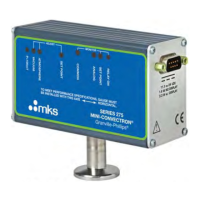Chapter 3
40 Mini-Convectron Module Instruction Manual - 275513
3.3.1 Preparing to Adjust Setpoint Relays
If the module will measure the pressure of any process gas other than N
2
or air, you must adjust
setpoint relays for the process gas that will be used.
The true pressure of a gas other than N
2
or air may be substantially different from the pressure that
the output indicates. For example, outputs might indicate a pressure of 10 Torr for argon, although
the true pressure of the argon is 250 Torr. Such a substantial difference between indicated pressure
and true pressure can cause over-pressurization resulting in an explosion.
Table 3-7, Figure 3-13 and Figure 3-14 enable you to determine the amount of voltage that
corresponds to a specific N
2
or air pressure.
1. Make sure the module is properly installed, the axis is horizontal (see Section 2.3), and the power
supply is ON.
2. Figure 3-13 and Figure 3-14 are graphs that show test point voltage versus pressure for N
2
or air.
Table 3-7 lists test point voltage versus pressure for 12 commonly used process gases, including
N
2
and air.
If you are using Figure 3-13 or Figure 3-14, find the point at which the horizontal line
representing the desired trip point for N
2
or air pressure intercepts the vertical line representing
test point voltage. For example:
• In Figure 3-13, a test point voltage of 0.64 V represents an N
2
or air pressure of 40 mTorr (5.3 x
10
–3
kPa, 5.3 x 10
–2
mbar).
• In Figure 3-14, a test point voltage of 4.8 V indicates an N
2
or air pressure of 40 Torr (5.33 kPa,
53.3 mbar).
If the gas being used is not included in Table 3-7, or for a gas mixture, you will need to generate
a calibration curve using a gas-independent transfer standard such as a capacitance manometer.
A built-in hysteresis prevents oscillation around the setpoint.
• For a module without a display, hysteresis is 2% of reading.
• For a module with the optional display, hysteresis is 10% of reading plus one significant digit.
Hysteresis depends on the vacuum chamber pressure at which the setpoint has been established
and on whether or not the module has the optional display.
3.3.2 Adjusting Setpoint Relays
The procedure for adjusting relays depends on the number of relays and on whether or not the
module has the optional display.
3.3.2.1 If the module without a display has one setpoint relay:
1. Use a high-precision, high-input impedance DVM to measure the voltage across the MONITOR
SET POINT and MONITOR COMMON test points on the module front panel.
2. Use a flat-head instrument screwdriver to adjust the ADJUST SET POINT potentiometer for the
Over-Pressure Conditions
Failure to use accurate pressure conversion data for N
2
or air to
other gases can cause an explosion due to over-pressurization.
If the module will measure any gas other than N
2
or air, before
putting the module into operation, adjust setpoint relays for the
process gas that will be used.

